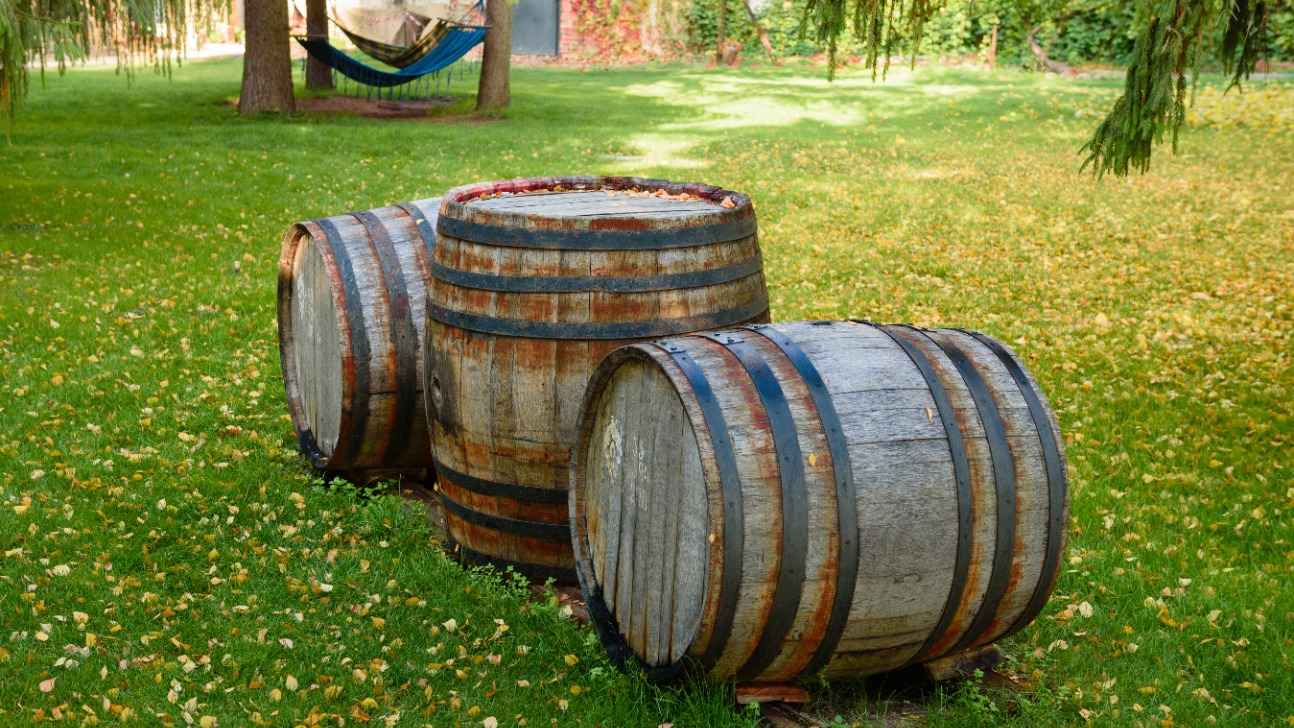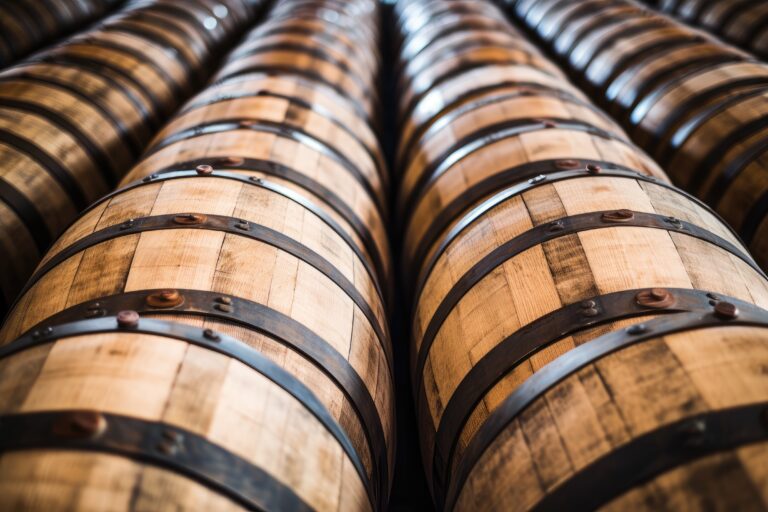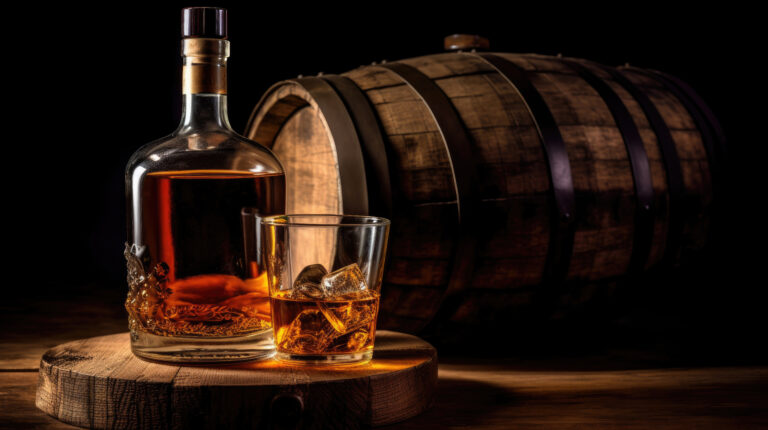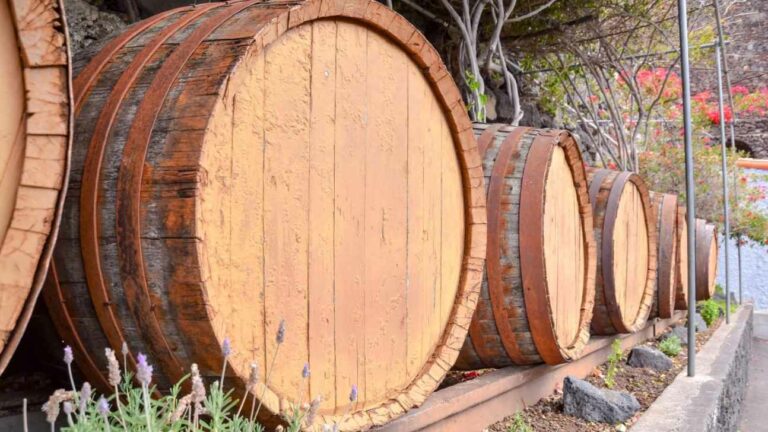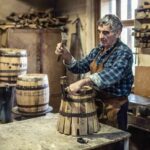Ever wonder about the second act for those sturdy oak barrels after they’ve lovingly aged fine whiskey? Well, pull up a chair, because there’s a thriving global dance of used whiskey barrels. Once the distillers have extracted all that golden goodness, these seasoned casks embark on a new journey, lending their character to beer, wine, cider, rum, or even tequila. You might have savored their influence without even realizing the barrel’s previous life.
This repurposing of whiskey barrels has blossomed into a significant international business, with a single used barrel fetching anywhere from $50 to $200. Not a bad return for a container that’s already generously imparted its distinctive vanilla and caramel flavors, hallmarks of whiskey aging, to its original spirit. As the thirst for barrel-aged craft beverages has surged, these ex-whiskey barrels have become a highly sought-after commodity. From the misty distilleries of Scotland to those in the Land of the Rising Sun, Japan, distillers are sending their spent casks across continents to patiently age and subtly flavor everything from robust stouts to vibrant rums.
For you, the curious imbiber, this translates to a wider spectrum of tastes, an expanded opportunity to explore how wood and the ghost of whiskey can transform other drinks. Keep an eye out for those enticing “barrel-aged” labels at your favorite local bar or liquor store. You never know, that intriguing beer, crisp cider, or nuanced tequila might have begun its life cradling whiskey, bringing along subtle whispers of smoky char and warm oak spices for the ride. Who knew recycling could be so delicious?
The Worldwide Popularity of Whiskey
The global palate has a deep appreciation for whiskey. This widespread demand fuels a dynamic international trade in used whiskey barrels, as distilleries not only sell their spent casks but also actively seek out used casks for their own aging and flavoring processes.
The Demand in Scotland and Ireland
In the historic heartlands of scotch and Irish whiskeys, distilleries rely on used barrels to nurture their spirits. These casks, often with a prior history of holding bourbon or sherry, impart unique flavor nuances. The demand for these used barrels is consistently high, leading distilleries to frequently resell their spent casks to those aging other types of spirits.
Flavoring Rum in the Caribbean
Across the turquoise waters in the Caribbean, rum producers eagerly acquire used barrels to age and flavor their distinctive rums. These seasoned casks gently pass on notes of vanilla and sweet caramel, often accompanied by delicate hints of toasted oak. Some premium rum brands achieve remarkable complexity by aging their spirits in a carefully curated mix of ex-bourbon and ex-sherry casks. Used barrels are undeniably a cornerstone in the art of crafting exceptional aged rums.
Maturing Tequila in Mexico
In the sun-drenched landscapes of Mexico, producers of high-quality tequila, particularly the revered extra añejo tequilas, utilize used barrels, with a strong preference for ex-bourbon casks, for the crucial maturation and flavoring process. These barrels elegantly enhance the inherent agave flavors, adding sophisticated layers of oak, warm spice, and a subtle hint of inviting smoke. Top-tier tequila brands often select used barrels that previously cradled premium whiskey marques.
New Life for Barrels Worldwide
The journey of used whiskey barrels extends far beyond these shores. They find renewed purpose aging fine brandy in France, rich port in Portugal, and even contributing to the character of burgeoning whisky industries in Taiwan and India. The enduring demand for these barrels stems from their remarkable ability to impart those distinctive flavor compounds that are the hallmark of whiskey aging. This global trade in used whiskey barrels beautifully illustrates how the tools of one craft can inspire and enrich another, all for the shared pleasure of exquisite taste.
How Whiskey Barrels Impact Flavor
Once the whiskey has reached its peak and is bottled, the barrels are emptied, seemingly spent. But don’t underestimate their lingering potential! Used whiskey barrels have become a prized commodity in the global marketplace precisely because of their remarkable ability to infuse flavor into other spirits and wines.
Early distillers intuitively discovered that aging spirits within charred oak barrels had a transformative effect, mellowing their character and enhancing their flavor profiles. The interior of these barrels undergoes a process of charring, or burning, which creates a layer of charcoal that subtly alters the chemical composition of the aging spirits. As the whiskey matures, it gracefully absorbs desirable flavors from the wood, such as sweet vanilla, rich caramel, and a hint of inviting smoke.
When these seasoned barrels are given a second life, aging other spirits like rum, fine brandy, or complex tequila, they generously impart subtle echoes of the whiskey they once held. The result is a more intricate, often slightly smoky, character in the newly aged spirit. Even wineries have embraced this trend, aging their wines in used whiskey barrels to achieve richer, fuller-bodied expressions with intriguing notes of oak and warm spice.
These bourbon-soaked barrels are such a hot commodity that a robust global market has emerged around them. Distillers from Scotland, Ireland, Japan, and Taiwan are keen to acquire used barrels from bourbon distilleries in Kentucky to age their own whiskeys. Meanwhile, rum distillers in Central and South America are utilizing them to craft exceptional spiced and aged rums.
With the worldwide appetite for barrel-aged spirits and wines steadily increasing, the trade in used whiskey barrels has evolved into a thriving industry in its own right. For distillers and winemakers, these barrels offer a cost-effective means of accelerating the aging process and adding desirable flavor complexity. And for discerning whiskey enthusiasts, this trend yields a fascinating array of new and innovative spirits and wines that carry a whisper of whiskey’s signature flavors. All thanks to a few well-traveled, bourbon-soaked barrels.
The Cooperage Industry and Barrel Production
The cooperage industry is the backbone of barrel production, particularly those essential vessels used for aging premium spirits like whiskey, fine wine, and flavorful beer. Barrel making, or cooperage, is a time-honored craft, an art form practiced for centuries. High-quality barrels are consistently in high demand within the global marketplace, especially among discerning distillers and vintners.
The Barrel-Making Process
Crafting a barrel is a meticulous process involving several key steps. Cooperages carefully source premium oak, such as the esteemed American white oak or the elegant French oak, and precisely cut the wood into staves, which will form the body of the barrel. These staves are then expertly shaped and beveled to ensure a tight fit, followed by a thorough sanding to achieve a smooth surface. Finally, sturdy metal hoops are fitted around the exterior of the staves, cinching them together to create a robust and leak-proof container.
Once assembled, the inside of the barrel undergoes the crucial process of charring. The intensity of the char, or burn, is carefully determined based on the intended use of the barrel. A lighter char is typically employed for wine barrels, while a heavier char is favored for whiskey. This charring process caramelizes the natural wood sugars and releases a complex array of compounds that will ultimately impart distinctive flavors to the aging spirit.
Aging Spirits
The newly constructed barrels are then filled with spirits such as robust bourbon, refined scotch, or rich rum, and patiently aged for a minimum of two years. As the spirit interacts with the charred oak barrel over time, it gradually absorbs both flavor and color. The longer the aging period, the more intricate and nuanced the resulting flavors become. Many premium spirits are aged for extended periods, sometimes ranging from 10 to 30 years, to achieve an exceptionally smooth and richly layered flavor profile.
Once a barrel has completed its initial aging duty, it is often sold to craft distillers or even private individuals. These “used” barrels still hold significant value, proving ideal for home aging experiments or even for decorative purposes. A thriving global trade exists for used whiskey barrels, particularly those with a history of aging bourbon. The lingering bourbon aroma and the residual wood sugars within these barrels can impart a distinctive and desirable flavor to any spirit subsequently aged within them.
For both established distillers and burgeoning craft brewers, investing in high-quality barrels is paramount to producing a premium, aged product. And for passionate spirit and wine aficionados, a used whiskey barrel can be the perfect vessel for embarking on a homemade aging adventure. The cooperage industry and the intricate barrel trade have been instrumental in perfecting the art and science of crafting fine aged spirits.
Global Demand for Used Whiskey Barrels
The used whiskey barrel trade has blossomed into a dynamic and expanding global market. Once whiskey distillers have finished aging their prized spirit, these valuable barrels are sold off, finding a multitude of uses across the world.
Aging Other Spirits
Used bourbon barrels are particularly coveted for aging a diverse range of other spirits, including smooth rum, complex tequila, and nuanced scotch. These seasoned barrels impart characteristic flavors of sweet vanilla, rich caramel, and subtle oak notes derived from the charred wood. Distillers spanning from Mexico to Scotland actively seek out and purchase used barrels to age their own spirits, creating uniquely complex flavor profiles.
Aging and Flavoring Beer
The innovative world of craft brewers has also enthusiastically embraced used barrels for both aging and adding intriguing flavors to their beers. Robust stouts, hearty porters, and complex sour beers are frequently aged in used bourbon barrels. These barrels contribute delightful notes of bourbon, warm oak, and sweet vanilla, which beautifully complement the malty, often chocolatey, flavors of stouts and porters. Sour beers also benefit from the interaction with the wood, which can mellow their tartness and add layers of depth and complexity.
Aging and Flavoring Wine
Some adventurous winemakers have begun experimenting with brief aging or “finishing” of their wines in used bourbon barrels. This short contact with the wood can impart subtle yet intriguing hints of bourbon and oak to full-bodied red wines such as elegant Cabernet Sauvignon, rich Malbec, and spicy Tempranillo. Even a few months spent in used barrels can create a nuanced flavor profile without overpowering the fundamental character of the base wine.
Wood Smoking Meat
The versatility of used whiskey barrels extends beyond beverages. They have also found a valuable second life as wood for smoking various meats, including succulent beef, tender pork, and flavorful chicken. The charred oak imparts a distinctive smoky flavor, often with a subtle sweetness, to barbecued meats. Barrel staves and charred barrel chips are readily available to home barbecuers and restaurants seeking to elevate the flavor of their smoked brisket, ribs, and bacon.
The used whiskey barrel is truly a versatile container, capable of adding depth and complexity of flavor to spirits, wine, beer, and even food across the globe. With a touch of ingenuity, distillers have fostered a sustainable closed-loop system where barrels first enhance one product before moving on to enrich another. This innovative reuse of materials is certainly worth raising a glass to.
Re-Use of Barrels in Winemaking
Once the precious whiskey has been aged to perfection in charred oak barrels, the barrels are emptied of their liquid treasure. However, this is far from the end of their useful life. Innovative winemakers have discovered that aging wine in used whiskey barrels imparts wonderful flavor notes derived from both the wood itself and any lingering whiskey residues.
A Popular Trend
Aging wine in whiskey barrels has gained significant popularity, particularly for bold, full-bodied red wines such as robust Cabernet Sauvignon, smooth Merlot, and rich Malbec. The whiskey-soaked wood infuses the wine with appealing flavors of sweet vanilla, warm caramel, and aromatic spice. Even the small amounts of whiskey that remain absorbed in the wood subtly blend into the wine, adding intriguing hints of honey and dried fruit.
Winemakers in the US, Australia, Chile, and Argentina are increasingly embracing this innovative aging technique. Some wineries are even forging partnerships with local craft distilleries to secure a reliable source of barrels. The results have been so successful and the resulting flavors so captivating that the demand for used whiskey barrels now often outstrips supply.
Perfect Pairings
Certain wine and whiskey combinations exhibit particularly harmonious synergy. For example, aging a structured Cabernet Sauvignon or a velvety Malbec in barrels that previously held smooth bourbon often results in a perfect marriage of flavors. The sweet, oaky notes of the bourbon beautifully complement the bold, dark fruit characteristics of these full-bodied reds. Similarly, barrels that once cradled peaty single malt Scotch whisky can impart a delicate touch of smokiness that elegantly complements the earthy, mushroomy undertones of delicate Pinot Noir.
Rather than overpowering the inherent qualities of the wine, the whiskey-infused barrels subtly enhance its natural characteristics. Much like a pinch of salt can elevate the flavors in food, the gentle influence of the whiskey barrel adds extra layers of aroma and taste, creating a more complex and intriguing final product. This harmonious relationship has transformed the global trade in used whiskey barrels into a thriving, artisanal industry.
Craft Brewers Embrace Barrel-Aged Beers
The creative world of craft brewers has wholeheartedly embraced the art of barrel-aging their beers to achieve remarkably complex and nuanced flavor profiles. Barrel-aged beers are typically ales or stouts that have been patiently aged for months, or even years, in wooden barrels that were previously used to mature spirits like whiskey, rich rum, or fine wine. As the beer interacts with the wood and any lingering spirit residue, its flavor profile undergoes fascinating and unique transformations.
Bourbon Barrels
Bourbon barrels, sourced from the distilleries of Kentucky and Tennessee, are particularly popular for aging robust stouts and hearty porters. These barrels impart delightful notes of sweet vanilla, warm oak, and rich caramel, often accompanied by subtle traces of the bourbon itself. Many brewers carefully age their beers for periods ranging from 6 to 24 months to achieve an ideal balance between the bourbon character and the inherent flavors of the beer. Some of the most highly regarded bourbon barrel-aged beers include Founders KBS, Goose Island Bourbon County Stout, and Firestone Walker Parabola.
Rum Barrels
Rum barrels are frequently employed to age bold imperial stouts. The rum barrels contribute intriguing flavors of molasses, brown sugar, and even a hint of tropical coconut, which pair exceptionally well with the roasted malt notes of the stout. A notable example is Cigar City’s Marshal Zhukov’s Imperial Stout, which undergoes an extended aging period of over a year in rum barrels.
Wine Barrels
Wine barrels, typically those that previously held elegant Cabernet, delicate Pinot Noir, or crisp Chardonnay, are often used to impart fruity and sometimes subtly tannic characteristics to ales such as refreshing saisons, complex sour beers, and nuanced Belgian-style ales. The wine barrel aging process can result in hints of stone fruit like cherries, as well as gentle oak tannins. Popular examples of wine barrel-aged beers include Crooked Stave’s Surette and Firestone Walker Bretta Weisse.
Barrel-aging is an evolving art form that continues to gain popularity within the craft beer community. Brewers meticulously select barrels and carefully control aging times to create truly unique and complex beers. The global trade of used whiskey and other spirit barrels enables smaller brewers to produce these innovative barrel-aged beers on a relatively manageable scale, contributing to greater flavor diversity and experimentation within the craft beer scene.
Innovative Uses for Used Barrels
Once the whiskey has been aged to its peak and carefully bottled, the barrels that once held this precious spirit often find themselves repurposed for a variety of innovative and creative uses.
Artisanal Crafts
Used whiskey barrels have become a popular material for small-batch artisanal crafts. Skilled woodworkers transform the individual staves into unique decorative wall panels, rustic tabletops, charming candle holders, and more. The whiskey-soaked wood lends these crafts a warm, rich color and a subtle, inviting aroma. Distilleries themselves also often repurpose their spent barrels into distinctive furniture for their tasting rooms, such as sturdy stools, comfortable chairs, and eye-catching bar tops.
Aging Other Spirits and Foods
The porous nature and lingering flavors within whiskey barrels make them ideal for aging a variety of other spirits, including smooth brandy, rich rum, complex tequila, and even other styles of whiskey. The wood gently imparts flavor notes from its previous tenant, adding layers of complexity to the new spirit. Beyond spirits, barrels are also employed to age and flavor diverse food items such as artisanal vinegars, rich maple syrup, spicy hot sauces, and tangy kombucha. Even homebrewers utilize smaller barrels to add unique character to their craft beers.
Home Décor
The rustic yet refined aesthetic of barrels makes them a striking decorative statement in homes. They are repurposed as unique end tables, comfortable ottomans, eye-catching planters, and practical umbrella stands. Cutting a barrel in half lengthwise can create a stylish bath caddy or a distinctive sink. Many choose to label and date the barrel to proudly display its provenance and history.
Cooking
Creative home cooks and innovative restaurants are finding new culinary applications for barrels. A converted barrel sauna or smoker can infuse food with a subtle hint of whiskey. Individual barrel staves or planks can be used for grilling or barbecuing meats and seafood, imparting a unique smoky flavor profile. Forward-thinking chefs are even experimenting with aging cheeses, butter, and preserved meats within barrels. Barrel-aged cocktails represent another innovative avenue for mixologists to enhance and differentiate their craft.
Gardening
Whiskey barrels make excellent and aesthetically pleasing planters, particularly well-suited for herbs, vegetables, and small trees. Their substantial size and convenient height make them ideal for patios and decks. The wood of the barrels helps to moderate soil temperature and retain moisture for the plants. As the wood naturally weathers over time, its tannins may even help to deter common garden pests. Some resourceful individuals even convert barrels into efficient compost tumblers.
Whether your interests lie in aging your own spirits, crafting innovative cocktails, or simply adding a touch of rustic charm to your home, used whiskey barrels offer a wealth of possibilities limited only by your imagination. Their rich provenance and undeniable rustic allure lend them a distinctive charm that readily inspires creativity.
Environmental Sustainability of Barrel Re-Use
The practice of reusing whiskey barrels is an environmentally sound and sustainable approach that effectively reduces waste and repurposes high-quality wood.
Saving Trees
By actively reusing barrels, distillers contribute to the conservation of valuable wood resources that might otherwise end up in landfills. Oak trees, the primary source for barrels, can take between 200 and 500 years to mature sufficiently for barrel production, making their preservation a critical environmental concern. Each instance of barrel reuse effectively saves a mature oak tree.
Decreasing Pollution
Discarded barrels occupy significant space in landfills and release harmful greenhouse gasses as they decompose. By embracing barrel reuse, the distillation process becomes inherently less polluting, contributing to a reduction in the overall environmental impact of whiskey production.
Economic Benefits
Beyond the environmental advantages, there are also compelling economic incentives for distillers to engage in barrel reuse. High-quality oak barrels represent a significant investment, often costing between $200 and $500 each. Reusing these barrels helps to significantly reduce costs for distillers, particularly for smaller craft distilleries operating with tighter profit margins.
Some barrels can be effectively reused up to three times before they are ultimately retired. Each instance of reuse typically involves re-charring and re-seasoning the interior of the barrel, which effectively restores it to a condition similar to new. This process revitalizes the barrel’s aging and flavoring capabilities.
While certain types of barrels, such as those used to age bourbon, are subject to regulations that mandate single use, the reuse of barrels for aging other whiskeys helps to maximize their utility while minimizing waste. It’s a sustainable practice that allows these meticulously crafted barrels to enjoy multiple lives, all while contributing to the creation of uniquely flavored spirits.
The global whiskey industry has increasingly embraced barrel reuse as an environmentally responsible initiative. Through cross-border cooperation, distillers are able to share and trade used barrels, making the most of these valuable natural resources. It’s a win-win situation for the planet, the economy, and whiskey enthusiasts worldwide.
The Future of the Global Used Barrel Trade
The global trade in used whiskey barrels has experienced rapid growth over the past decade. Where is this dynamic market headed in the future? Here are a few potential trajectories for the future of used barrels:
Increasing Demand
The demand for used barrels is highly likely to continue its upward trajectory. As the craft spirits industry expands its global reach, an increasing number of distillers will require barrels for both primary aging and finishing processes. Used barrels offer an economically attractive and sustainable option. Furthermore, the burgeoning trends of barrel-aged cocktails and flavorful barrel-aged beers are also significant drivers of this increasing demand. Some industry analysts even predict the potential emergence of a barrel shortage.
New Markets
The used barrel trade has the potential to expand into previously untapped markets. For example, the wine industry has begun to explore the use of used barrels for aging and blending wines, seeking to impart unique oak and subtle spirit-derived flavors. Similarly, cideries and breweries are increasingly experimenting with the nuanced effects of barrel aging. Barrel brokers may find new opportunities in sourcing and supplying barrels to these evolving industries. Additionally, regions in Asia, Africa, and South America, where whiskey consumption is on the rise, present potential new markets for the used barrel trade.
Innovation
There is considerable scope for innovation within the used barrel space. For instance, specialized barrel refurbishing and re-charring services can help to maximize the lifespan and maintain the quality of barrels. Some distillers are employing customized techniques such as barrel smoking, barrel steaming, and controlled barrel firing to impart unique characteristics. Others are exploring the use of different wood species, varying toast levels, and alternative barrel shapes. This ongoing experimentation has the potential to create new and differentiated products for barrel brokers to source and distribute.
Sustainability
Sustainability will likely play an increasingly important role in the used barrel trade. Barrel brokers and distillers will need to prioritize the sustainable sourcing of barrels, ensuring they originate from legal and ethical sources. The very act of reusing barrels is an environmentally responsible practice, reducing waste and the demand for new oak. There is also potential for upcycling used barrels into furniture, decorative items, and even building materials. Policy changes may further encourage more sustainable practices within the global barrel market.
The future of the used whiskey barrel trade appears bright, with numerous opportunities for continued growth, innovation, and an increasing focus on sustainability. Distillers, brewers, and entrepreneurs worldwide will undoubtedly continue to explore the art of aging, blending, and experimenting with barrels of all kinds. And barrel brokers will play a crucial role in sourcing and distributing these valuable used barrels, effectively connecting supply and demand across the globe. The outlook for this burgeoning market is undeniably promising.
Final Thoughts
So, the next time you savor a sip of a well-aged whiskey or a fine bourbon, take a moment to appreciate the humble barrel in which it patiently matured. A used barrel, once deemed spent by one distiller, often embarks on a new chapter, lending its character to the aging of other spirits. This global exchange of secondhand oak barrels not only allows for more affordable aged spirits but also fosters unique flavor profiles resulting from the subtle interplay of different distillates within the wood, all while promoting a more sustainable model of reusing these meticulously handcrafted vessels. Though these barrels travel far and wide, the final result in your glass offers a taste of terroir, tradition, and the passage of time. A single sip can transport you across continents and connect you to centuries of craftsmanship. Not bad for what might otherwise be considered a discarded piece of oak. The global whiskey barrel trade serves as a compelling testament to the idea that one person’s trash can indeed become another’s treasure.
